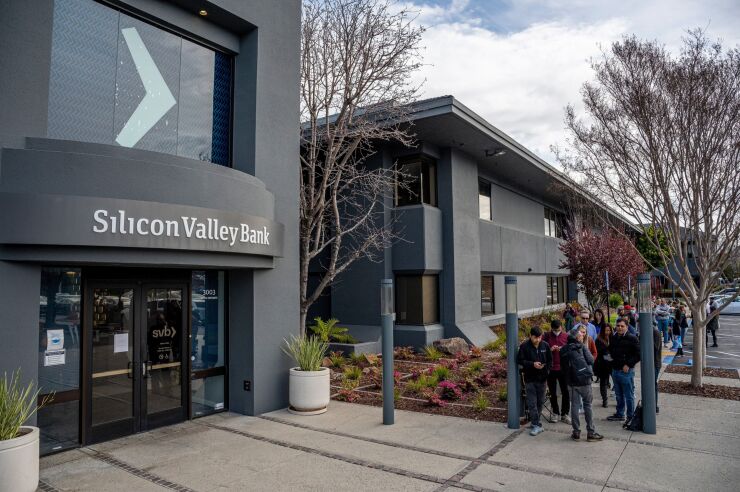
For about eight months last year, as Silicon Valley Bank struggled to manage rising interest rates and a downturn in the technology sector, its
Now, a new bill aims to make sure that doesn't happen again. Legislation introduced this week by Democrats on the House Financial Services Committee seeks to codify regulatory requirements that large banks have a chief risk officer in place.
The bill, sponsored by Rep. Sean Casten, D-Ill., would require large banks to inform regulators of a chief risk officer vacancy within 24 hours of such a vacancy. Within seven days, they would have to file a plan with regulators outlining how they intend to "search for and promptly hire a well-qualified" chief risk officer.
If the job is still available after 60 days, the legislation would cap the bank's asset growth until the position is filled. The bank would also be required to inform the public of the vacancy.
In an interview Thursday, Casten said that Silicon Valley Bank's lack of a chief risk officer for eight months "created a significant gap in the public's understanding" of its risk profile.
"There are a whole lot of circumstances where you might have to replace" a chief risk officer, Casten said. "But if you have a concern that your bank does not currently have a risk officer that is sophisticated enough to deal with the risk your bank is taking, then for goodness sake, you shouldn't be growing and getting to the point where you have systemic risk to the system."
The bill is one of 11 pieces of legislation that House Democrats have introduced in response to the
The bills include proposals aimed at increasing the accountability of executives in charge of failed banks, restricting stock sales by executives whose banks haven't resolved regulatory citations and excluding the nation's smallest banks from paying special assessment fees that the Federal Depository Insurance Corp. currently charges to cover the costs of bank failures.
Three of the proposals were introduced by Rep. Maxine Waters, D-Calif., the highest-ranking Democrat on the House Financial Services Committee. One of her measures calls for large banks without holding companies to be subject to capital, liquidity, stress testing and resolution planning requirements that are similar to those of large banks with holding companies.
The other two bills introduced by Waters call for expanding regulatory authority both to
On Wednesday, the Senate Banking Committee
In a press release, Waters urged House Financial Services Committee Chair Patrick McHenry and committee Republicans to work with Democrats "to quickly advance these much needed reforms in order to protect our banking system, economy and our nation's consumers from any future harm."
Spokespeople for McHenry, R-N.C., did not respond Thursday to emails seeking comment. McHenry's office has previously said that in the wake of the recent bank collapses, it has focused on accountability for regulators.
The March 10 failure of Silicon Valley Bank heightened the attention paid to the chief risk officer job, a C-suite-level role that oversees risk management on an enterprise-wide level.
In a proxy statement filed seven days before its failure, Silicon Valley Bank disclosed that former Chief Risk Officer Laura Izurieta agreed to step down from her job in late April 2022 and take a non-executive, transition-related role that would last for five months. Her successor, Kim Olson, who came from Tokyo's Sumitomo Mitsui Banking Corp.,
Last month,
Becker, who led the bank and its parent company, SVB Financial Group, for 12 years, said that he and the company's board of directors decided in late 2021 and early 2022 to "look for an even more experienced" chief risk officer, based on feedback from regulators.
Becker told lawmakers that he expected it would take six to nine months "to find the best person."
To make sure the bank "had coverage while looking for a chief risk officer," the company created an "office of the CRO" that reported to Becker and the chair of the board's risk committee, Becker said. The company also kept Izurieta on board as a consultant through Oct. 1, 2022, "to make sure there were no gaps during that period of time," he added.
In a post-mortem on Silicon Valley Bank's failure, the Federal Reserve laid out a timeline for the decision to replace Izurieta. The Fed said that SVB's board, management and chief risk officer "all failed to recognize that their year-long program for the risk management framework" to meet enhanced prudential standards "was ineffective until supervisors started identifying issues in late 2021."
The
"While it is the responsibility of the businesses and functions like finance and treasury to manage risk in a safe and sound way in accordance with the board of directors' risk appetite, the vacancy in a post like CRO removes one layer of important internal oversight," the Fed said in its report.






